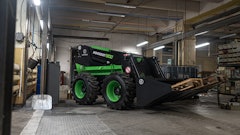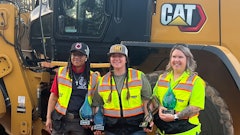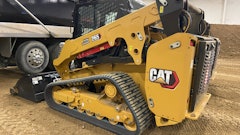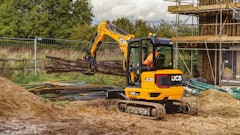
Compact wheel loaders have proven an effective solution to fill the gap between skid steers and larger, full-size equipment. "Sometimes a full-size tractor-loader-backhoe or other equipment may be too large for a given work site, yet a skid steer or track loader may be too small to handle the job," Keith Rohrbacker, product manager, Kubota, points out.
But if current trends continue, this gap may not exist much longer. Skid steers are being introduced in increasingly larger size classes and capacities (see "Super Size Your Skid Steer", October 2010), with the potential to take on tasks formerly relegated to small wheel loaders.
"Large skid loaders have grown in popularity in recent years due to the power, lifting ability and sheer performance that they provide," says Kelly Moore, Gehl product manager, skid and wheel loaders. "Compared to a wheel loader, skid loaders in this category have more engine and hydraulic performance, giving them the ability to power a wide variety of attachments. When working on jobsites with limited space, skid loaders excel over wheel loaders due to their ability to turn within their own radius -- 360° turns are possible when needed."
Skid steers are also typically less expensive to acquire. According to David Caldwell, training/product manager at Takeuchi, the purchase price for a large skid steer may range from about $30,000 to $50,000, with monthly rental rates from $1,800 to $2,500. A compact wheel loader may cost from roughly $55,000 to $100,000 to purchase and $1,800 to $2,900 to rent.
"Pricing will always vary, but generally wheel loaders cost 12% to 18% more than a skid loader due to the design and component cost within these machines," Moore acknowledges. "Rental rates will correspondingly be higher on a wheel loader, as well."
The lower initial cost of a skid steer can be appealing given current economic conditions. But as with any type of acquisition, it's important to look beyond price. "The skid steer may meet a customer's immediate, short-term financial requirement, while providing satisfactory performance at the lowest cost. This being said, the compact wheel loader may actually be the better choice if the cost of ownership and the application are carefully evaluated," says Caldwell. "The compact wheel loader will consume less fuel, require considerably less maintenance and have a higher resale value."
"A major benefit is that wheel loaders are more economical to operate, offering up to 30% fuel savings," adds Jay Baudhuin, compact equipment product manager, Wacker Neuson. "Due to the design, skid-steer loaders need larger engines, and are less fuel efficient to run the hydraulics of the machine."
Of course, fuel savings will vary, and must be weighed against the application requirements. "Wheel loaders usually have smaller sized engines, are more economical and quieter than a skid loader," Moore comments. "On the other hand, a skid loader will be more suited for a job requiring higher hydraulic output to run demanding attachments."
TIRES, TURF AND TERRAIN
The skid-style steering of skid-steer loaders has its benefits -- and its drawbacks.
"A skid steer must rotate and change direction by skidding on the surface it is operating on, causing considerable tire wear," says Caldwell. "On the other hand, a compact wheel loader has an articulation point it utilizes for directional changes, reducing tire wear and replacement costs considerably."
Because the wheel loader does not skid on the tires to turn, the life expectancy of tires is greatly increased, Baudhuin indicates. "Tires are a costly maintenance item. Overall, repair and maintenance cost for a wheel loader is less than that for a skid steer," he asserts.
Frequent use on hard surfaces only exacerbates the differences in tire longevity. "Skid loaders' skid-style steering tends to increase tire wear when operated on hard surfaces like concrete, whereas a wheel loader will have a longer tire life due to the articulated-style steering," says Moore. "If a contractor finds that tire wear is becoming an issue from extensive operation on hard surfaces, a wheel loader might be a better option to have."
Skid-style steering can also affect jobsite restoration requirements. "Some projects require that minimal surface damage is inflicted. A skid loader would be less attractive in such a situation," says Moore.
"With their articulated four-wheel steering, compact wheel loaders won't cause damage to turf when turning, reducing the need for repair work when working on turf and other sensitive surfaces," says Rohrbacker. "This also helps to maximize tire life."
Rough or steep terrain can favor a wheel loader, as well. "The compact wheel loader is capable of working in varied terrain and adverse conditions, thanks in part to an oscillating frame or axles," says Caldwell. "[They] also have a longer wheelbase that helps improve stability and ride quality."
Four-wheel drive and limited-slip differentials on some models further aid operation in tough conditions, as does the ability to adjust performance to conditions.
"Kubota's load-sensing hydrostatic transmission enables efficient load handling by automatically adjusting speed and torque as load conditions vary," Rohrbacker states. In addition, a travel speed limiter reduces maximum travel speed with the push of a button while maintaining full performance of auxiliary hydraulics. This allows for efficient operation in tight spaces.
APPLICATIONS ABOUND
Today's quick-coupler designs allow many compact wheel loaders to utilize a variety of skid-steer attachments. "Most attachments interchange easily between the two machines," says Moore, "putting tools the contractor already owns to good use."
This has expanded the realm of applications available to these machines. "Wheel loader applications are endless, from general construction, landscape, snow removal, utility, etc.," says Baudhuin, "but they are especially beneficial where travel speed, higher lifting forces and turf preservation is needed."
"Compact wheel loaders have greater lifting capacities and lifting heights than skid steers, allowing them to do a variety of tasks the skid steer simply cannot perform," says Caldwell. "The compact wheel loader is also capable of higher travel speeds and is equipped with front and rear combo lights that allow them to be utilized on the road, unlike a skid steer."
Another benefit, says Caldwell, is a spacious operator station with improved visibility and easier entry and exit. "A compact wheel loader has a more comfortable operator station with better visibility that contributes to safety and increased productivity," he asserts. "A compact wheel loader also provides greater production capacity and a longer life."
"The compact wheel loader offers higher lifting forces and heights, higher travel speeds, a larger more comfortable cab, 360° visibility and no tearing of the turf," Baudhuin sums up. "Applications that require any of these items make the compact wheel loader the ideal choice for the contractor."
So while a large skid steer may be tempting from an initial cost standpoint, it's important to compare the applications and machine features and capabilities carefully. "When considering a choice between the two products, customers should consider all of these factors so they can make an informed decision," Caldwell emphasizes. "It may, after all, make more sense for them to give serious consideration to the compact wheel loader when they evaluate their needs. It may have a bigger impact to the bottom line over the life of the machine."





























